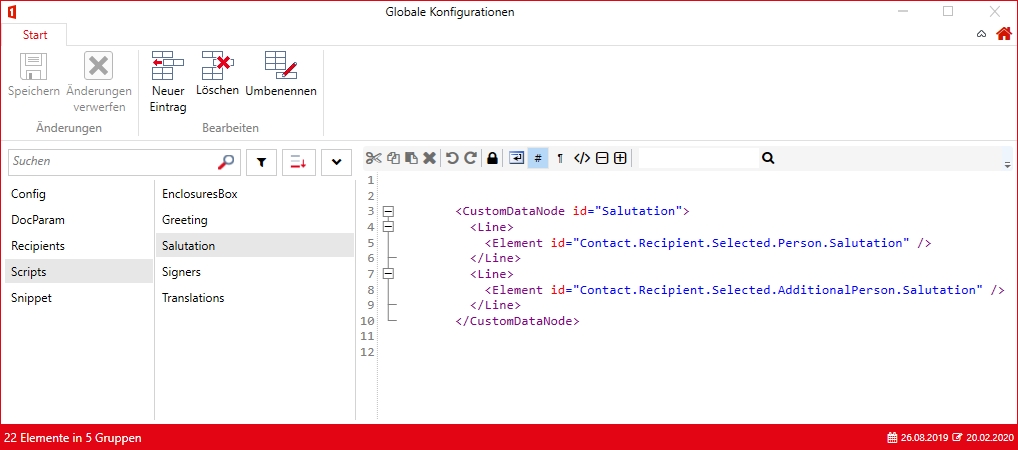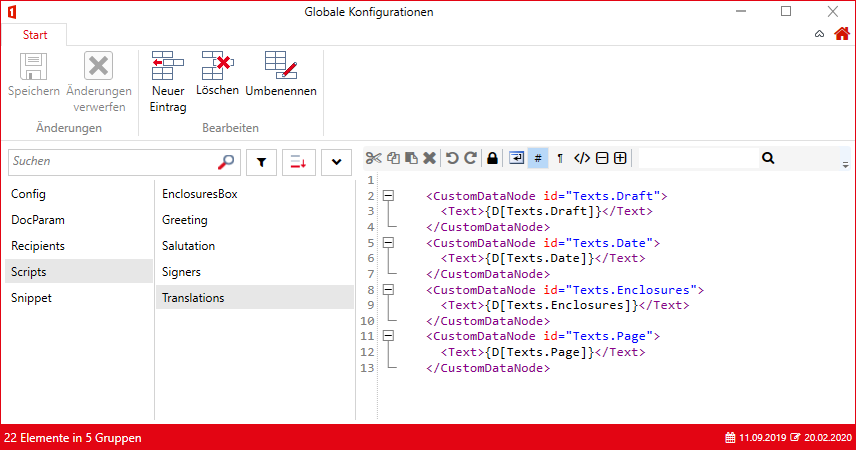Global Configurations
In the Global Configurations all information and configurations are stored divided into groups, which are used in several templates. The advantage is that the texts and configurations only have to be changed in one place. If, for example, the configuration for the address providers were built into each layout template, each layout template would have to be edited individually when an adjustment was made.
References
The information is located in data sets (data tag), which in turn are located in groups (group tag). The content in a data set is linked in a configuration according to the following pattern: {[GroupName.DataName]}.
Example 1 – Text
The globally stored record "Config.Depth" contains the value 5:

The record can now be linked in all XML configurations of the document functions. For example, in the XML configuration of the document function Scripts:
<?xml version="1.0" encoding="utf-8"?>
<Configuration>
<Script engine="XSL" version="2" depth="{[Config.Depth]}">
<!-- Insert scripts here -->
</Script>
</Configuration>
{[Config.Depth]} is now replaced with 5 each time. The script results are calculated 5 times. If this value needs to be adjusted, this can be done once in the Global Configurations. Consequently, this change will be automatically adjusted in all templates that contain {[Config.Depth]}.
Example 2 – Whole script
The globally stored record "Salutation" contains a script:

The "Salutation" script is initially used in all customer solutions as the default script for the salutation in a letter. Therefore, it is linked in correspondence templates in the "Scripts" document function:
<?xml version="1.0" encoding="utf-8"?>
<Configuration>
<Script engine="XSL" version="2" depth="{[Config.Depth]}">
{[Scripts.Salutation]}
<!-- different references -->
{[Scripts.Greeting]}
{[Scripts.Signers]}
{[Scripts.EnclosuresBox]}
</Script>
</Configuration>
{[Scripts.Salutation]} is now replaced with the corresponding content from the Global Configurations. The content is a script that attracts two Contact elements. So in the document finally the salutation is inserted, which was selected by the user in the recipient dialog.
Example 3 – Ganzes Skript mit Übersetzungen
The globally stored record "Enclosures" contains a script with a translation:

The "Enclosures" script is mainly used in letters, as it creates a list of all enclosures entered in the document parameter. That is why it is linked here in letter templates in the document function "Scripts":
<?xml version="1.0" encoding="utf-8"?>
<Configuration>
<Script engine="XSL" version="2" depth="{[Config.Depth]}">
{[Scripts.Enclosures]}
</Script>
</Configuration>
{[Scripts.Enclosures]} is now replaced with the corresponding content from the Global Configurations. The content is a script with a translation and the reference to a document parameter field. The translation is fetched from the Global Translations using {D[Texts.Enclosures]}.
Example 4 – Script with translation
The globally stored "Translations" dataset contains several scripts with text content:

The scripts (e.g. "Texts.Draft") contain translations that can serve in all letters. Therefore the record is linked here in a layout template in the document function "Scripts":
<?xml version="1.0" encoding="utf-8"?>
<Configuration>
<Script engine="XSL" version="2" depth="{[Config.Depth]}">
<!-- Translations -->
{[Scripts.Translations]}
</Script>
</Configuration>
{[Scripts.Translations]} will now be replaced with the corresponding content from the Global Configurations. In all templates based on this layout template, these translations can be inserted into the template as a text field. If a word needs to be adjusted, this can be done once in the Global Translations. Afterwards, the change will be applied directly in every template that has this translation linked.